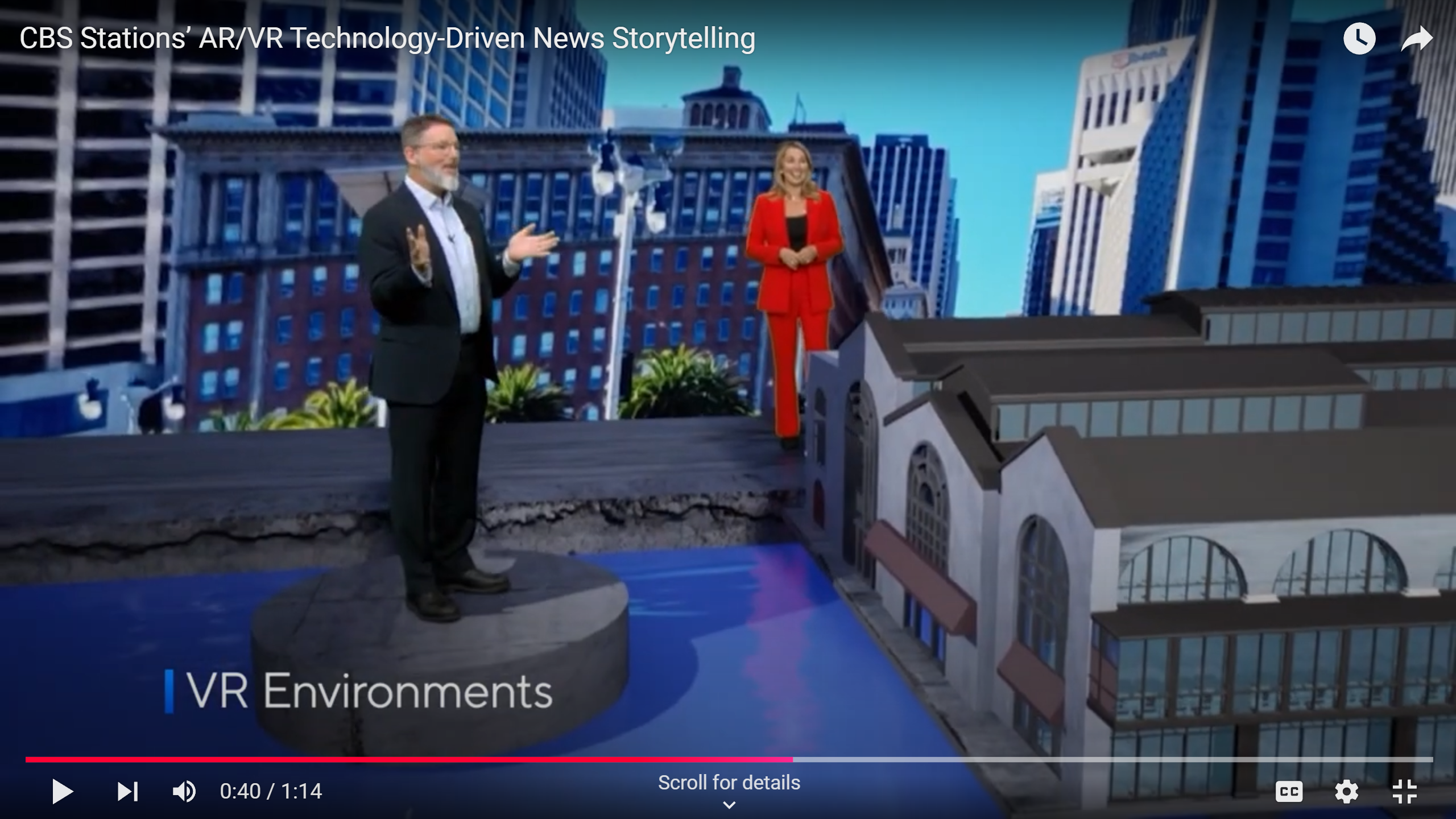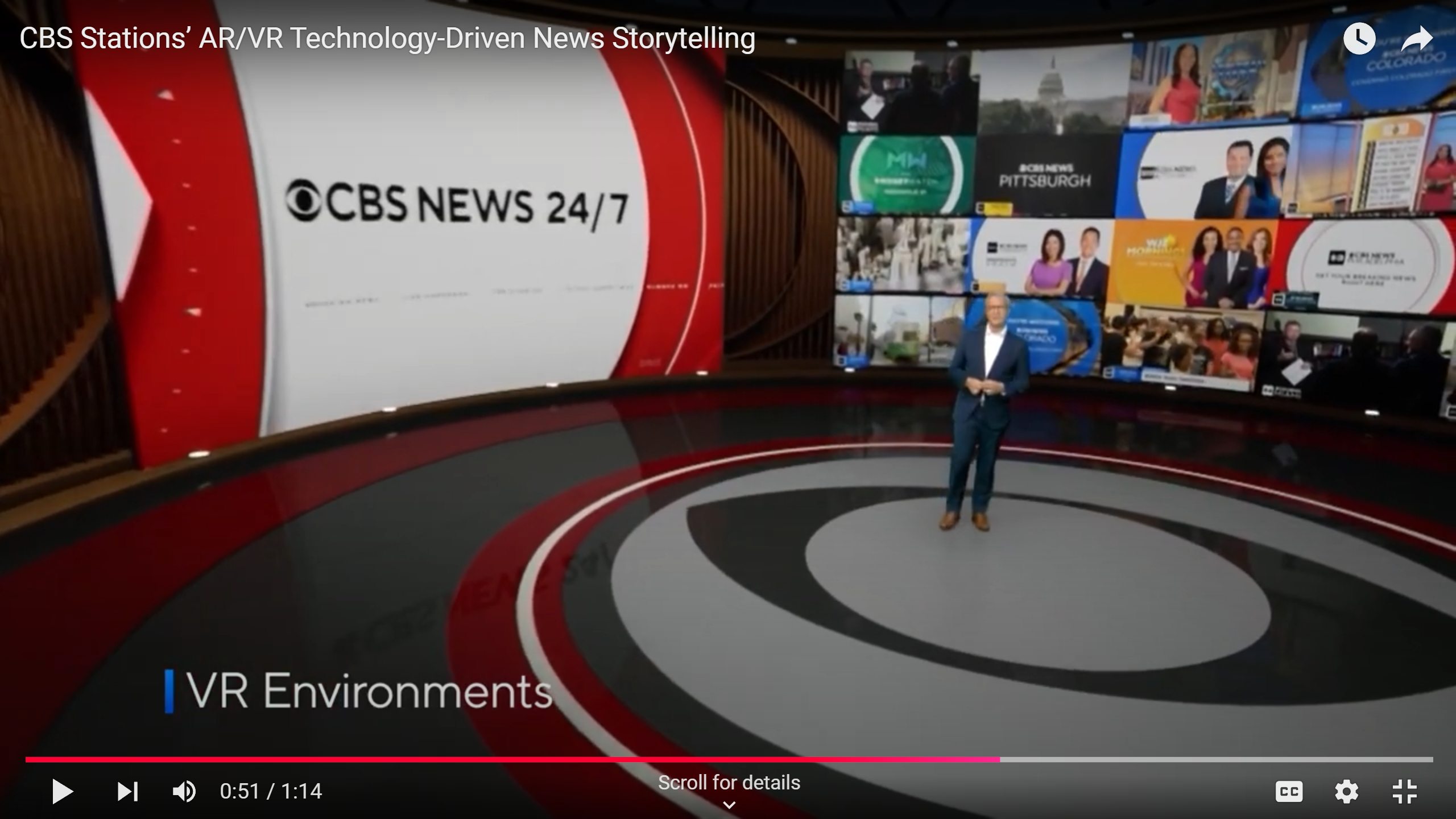CBS Owned Stations Go Virtual To Reinvent News
An innovative AR/VR platform developed by KPIX-KPYX in San Francisco has since been rolled out to five stations and the CBS News 24/7 streaming service

Visitors to the CBS News and Stations-owned KPIX-KPYX San Francisco will find a bustling local news operation producing 60 hours of local news each week that has recently abandoned a longtime centerpiece of traditional local news production—the TV news set.
Those sets disappeared in September, about a year after the stations deployed an innovative augmented reality/virtual reality platform for its news operations. The new AR/VR system had been so successful, first with weather and then all their coverage, that “One day, we asked ourselves why we needed hard sets?” CBS Bay Area President and General Manager Scott Warren recalled. “So, we just walked in and started busting them out. Now it is all AR/VR. We have no hard sets. There's no desk, there's no monitors. And every single show was like that.”
“I believe we are the first station to do that,” he added.
And, as this YouTube sizzle reel shows, the technology has been applied to a wide range of subjects, from immersing viewers in San Francisco's famous fog, to sports, politics, entertainment and election coverage.
The decision to go all in on AR/VR technologies was part of a wider effort by the station group to reinvent the way local news stories are presented and distributed to audiences that has led to the creation of a new hyperlocal news operation in Detroit, a Local News Innovation Lab in Texas, a dramatic expansion of the local news offered by CBS-owned stations and other initiatives.
“We all know we're in a challenging place right now in our industry,” explained Jennifer Mitchell, president of Stations and Digital for CBS News and Stations, who oversees 23 of 27 CBS-owned stations and the division’s local and national digital properties like CBS 24/7. “It‘s not just us, it's everybody. There's so much rapid change from an audience perspective. We have to change. The audience and the industry is changing.”
To encourage more innovation, the group also brought in new local leaders like CBS Bay Area president and GM Scott Warren.
The professional video industry's #1 source for news, trends and product and tech information. Sign up below.
“The San Francisco market is the perfect market to take risks, to experiment, to incubate big ideas and test and either fail or succeed and scale,” Mitchell said.
In San Francisco, much of the focus on finding new ways to operate has been driven by the need to improve storytelling and engage audiences.
“Everything starts with a really great story,” Warren said. “But how do you present those stories? And that's why we embraced AR and VR to enhance that storytelling, to provide context for that storytelling.”
Weather First
As they began developing the system in January 2023, CBS Stations executives felt that the logical first application for AR and VR should be weather, which was ripe for innovation. “We [broadcasters] have been looking at weather the same way for 50 years,” Warren said. “We have different people in front of the maps and the maps have gotten better, but we’ve been basically covering weather the same way for 50 years.
“Weather is that perfect opportunity to change the way we tell stories, because it is so immersive,” he continued. “You stand in it. You feel it. You can see it when you look up at the clouds, at mountain ranges. All of these impact the way weather affects each and every one of us. So we started thinking about how we could take weather and weather data and explain it in a whole new way.”
CBS stations are now taking real-time weather data from National Weather Service and other weather information suppliers and “translating that data, the ones and zeros, into weather graphics that our presenters can walk interact with and use to explain things in different ways,” Warren said.
This proved so successful the station then applied it to sports coverage, politics, elections and other topics.
“We quickly went to immersive newscasts as well,” he said. “So entire newscasts are now in AR and VR.”
In the development process of the system, the stations worked with Myreze, a branding and virtual production company. It also decided to adopt Zero Density’s virtual solution, rendering from the Unreal Engine and camera tracking from Stype.
Jeff Jeandheur, director of broadcast operations and engineering, and a team of tech and operations staff that included Eliot Curtis, director of technology innovation, and Chad Simpson, studio operations and integration manager, also played a central role.
This team melded and adapted the VR/AR technologies into a system that could be operated for hours each day on the relatively small budget of a local broadcast station.
“In the past, if you look at the NFL, or you look at Fox or places that have used this technology in the past, they've had to have giant teams and giant budgets come in to do this,” Warren said. “We have figured out, through the coding work and our staff and through our partners, a way to do this on the local level so that all of this data can come in in real time to change the look and feel in the story that's happening. For the first time, a local newsroom can use this technology without a huge team of people working on it.”
The Secret Sauce
The importance of in-house talent in the effort is a reminder of the deep reservoirs of talent and innovation that have been an important part of broadcasting. “Our partners have been great,” Warren said. “But the real secret sauce is what our internal staff has done, how they’ve taken all of the different partnerships and sewn them together with original coding and put it into a newscast that can be created in an automated control room.
“Jeff Jeandheur is kind of a mastermind at looking into the future and trying to figure out things,” Warren added. “And he has brought in a team of people that are all MacGyvers. They live and thrive on solving problems.”
That internal talent also played a key role in expanding deployments to other stations in the group.
“We were literally walking down a new path and there were fears this new technology wasn't going to be reliable and we won't be able to know how to use it,” Warren recalled. “But the more we worked with it, the easier it became, and the better we got at being able to turn things around quickly and teach others in-house how to use this. So once we got it down, which took us about a year, we got to the point where we can go into another station now, and in six to eight weeks have the entire thing built up and ready to go.”
These deployments also relied heavily on the internal talent at other CBS stations, where tech teams quickly embraced the idea and began to develop their own innovations, Mitchell said. “Their energy is infectious,” she said. “It energizes our other stations, our other operations. They are looking at what has been done in San Francisco. They want to bring it to their market.”
“All of those teams are taking the same sort of hungry and passionate approach to innovation,” Warren added. “They’re coming up with new things and new ways to do stuff and showing them to us. And that’s where this really scales. We’re all benefiting from each other.”
The system has been deployed at CBS-owned stations in New York, Philadelphia, Chicago and, most recently, Denver, with plans to deploy it at more stations.
In June it also went live on streaming news service CBS News 24/7 Mitchell explains that it was first used in a two-hour whiparound show called “CBS 24/7” that features breaking news from all of the company’s national, local and international news outlets and operations.
“The flagship show for CBS News 24/7 of the same name is now 100% virtual,” Mitchell said. “When you look at that wall of monitors on that show, that is all in the green space.”
Such technologies will also take center stage during the upcoming Election Night coverage. “We have infused AR VR and the virtual studios and content into almost every aspect of our newscast where we can and in markets” where it has been deployed, Mitchell said. “So, of course, on election night, you will be seeing those capabilities on display. It will look and feel different than Presidential election years in the past.”
George Winslow is the senior content producer for TV Tech. He has written about the television, media and technology industries for nearly 30 years for such publications as Broadcasting & Cable, Multichannel News and TV Tech. Over the years, he has edited a number of magazines, including Multichannel News International and World Screen, and moderated panels at such major industry events as NAB and MIP TV. He has published two books and dozens of encyclopedia articles on such subjects as the media, New York City history and economics.




